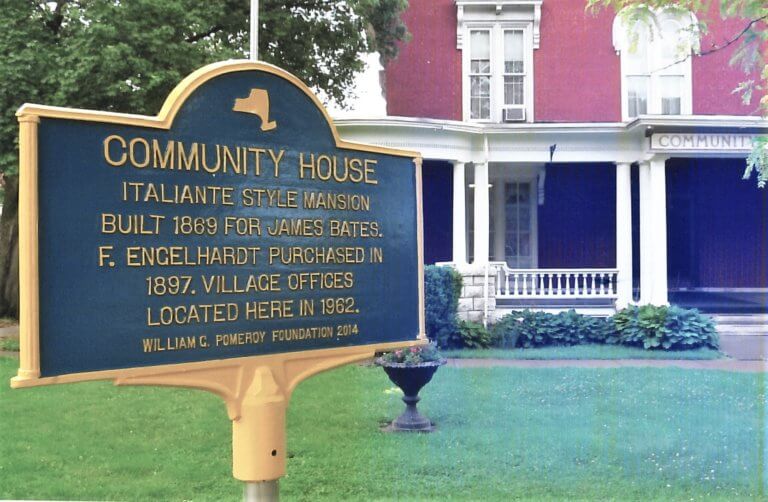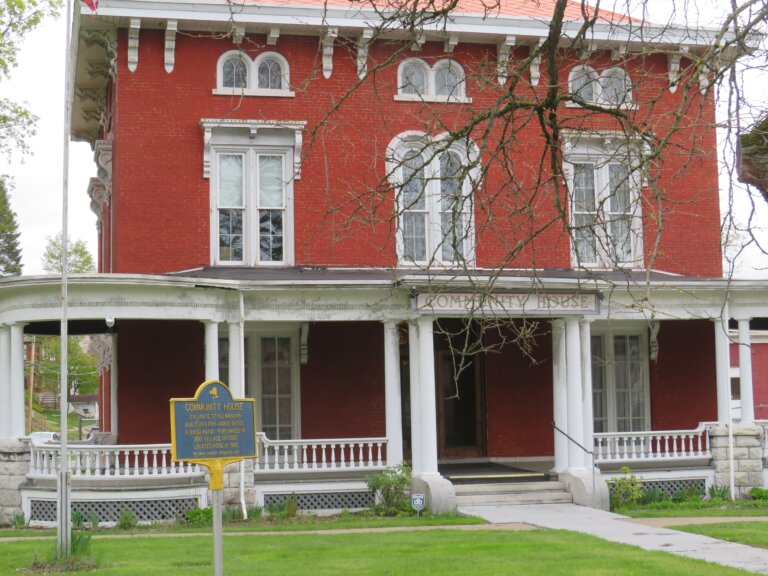COMMUNITY HOUSE
- Program
- Subject
- Location
- Lat/Long
- Grant Recipient
-
NYS Historic
-
House
- 16 Washington Street, St. Johnsville, NY
- 42.999906, -74.677095
-
Village of St. Johnsville
COMMUNITY HOUSE
Inscription
COMMUNITY HOUSEITALIANATE STYLE MANSION
BUILT 1869 FOR JAMES BATES.
F. ENGELHARDT PURCHASED IN
1897. VILLAGE OFFICES
LOCATED HERE IN 1962.
WILLIAM. G. POMEROY FOUNDATION 2014
According to local sources, James Bates was a local cheese buyer who made his fortune in the years following the Civil War, allowing him to build this magnificent mansion. By 1875, Bates’ fortune had turned and the house was sold. Frederick Englehart purchased the property in 1897 and expanded the home using his skills as a master woodcarver. It was donated to the Village of St. Johnsville by Jospeh Reaney, president of the First National Bank of St. Johnsville in 1933, eventually becoming home to the village offices.
Local village historian, Anita Smith, recorded the history behind the Bates house in her 2011 book, Village of St. Johnsville Sesquicentennial History. Smith stated that the architectural design of this home was influenced by the Italian Villa style it incorporated features such as a “square form, flat roof, and octagonal shaped cupola observatory on the roof, large cornices and decorative spooled brackets, arched and bracketed windows and a colonial style entrance doorway.” According to Smith, the limestone and brick used were all locally sourced. In 1875, the Bates family lost their fortune and the house was sold to William Peck (Village of St. Johnsville Sesquicentennial History).
The St. Johnsville Tax Roll indicates that Frederick Engelhardt purchased the property in 1897. He renovated the house, applying his own woodworking touches throughout. Engelhardt was born in Germany and upon arriving in America utilized his unique woodcarving skills to build pianos in the late 1870s (History of Montgomery County, Washington Frothingham, 1892). In 1890 he partnered with A.P. Roch and started his own piano manufacturing business in New York City. Smith recalls in the Village of St. Johnsville Sesquicentennial History that Engelhardt opened his first factory, Frederick Engelhardt & Sons Piano Manufacturers, around 1889. At this time in history, a player, or self-playing piano, was a novelty. One of the first self-playing pianos on the market was the Peerless Piano, manufactured by Engelhardt’s company (Village of St. Johnsville Sesquicentennial History). According to Smith, Engelhardt’s factory had a positive impact on the village’s economy. It employed over 400 local residents. Engelhardt hosted many public gatherings and even he had the Peerless Piano Factory Band perform on his deck. Unfortunately in the 1920s, the Engelhardt family’s financial situation changed and by the 1930s they were out of business.
Following Engelhardt, the house and property were owned by the First National Bank of St. Johnsville until bank president, Joseph Reaney, bought the property and donated it to the village in 1933 (Village of St. Johnsville Sesquicentennial History). Municipal offices moved into the mansion in 1962. The house was added to the National Register of Historic Places in 1989.


